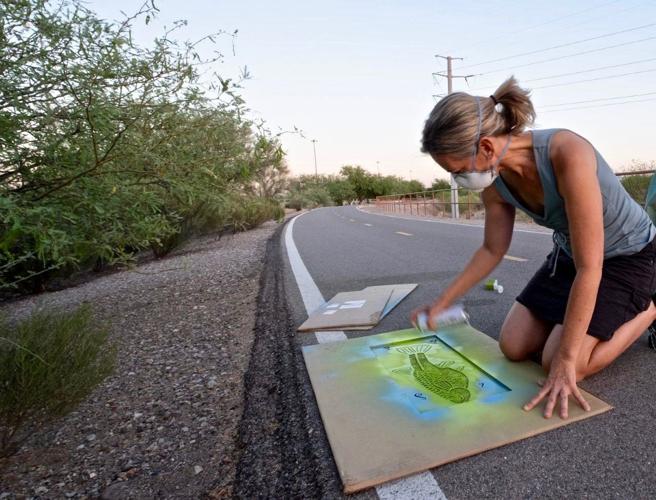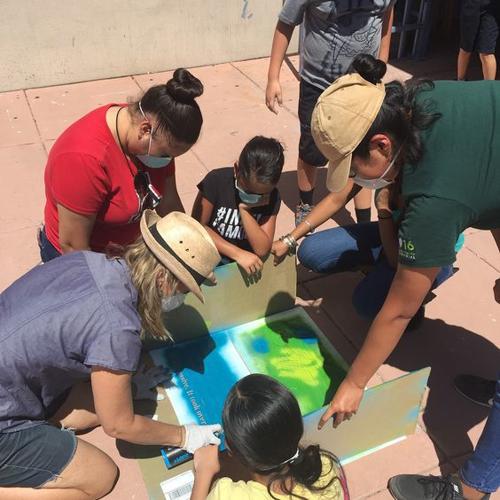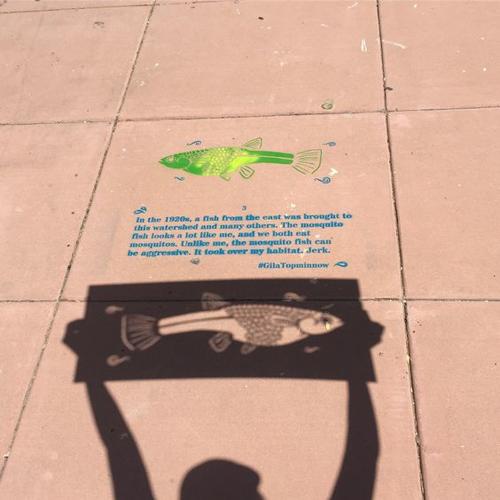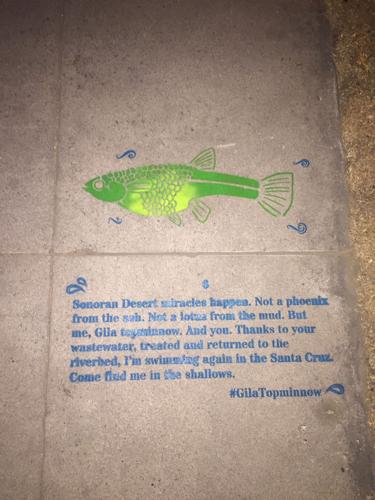Walking through Armory Park Neighborhood on a Friday morning, cicadas buzzing, artist Kimi Eisele marvels over the abundance of the desert.
She recalls a saguaro she encountered the previous night, its ruby-red fruit dotting the brown earth.
"I love the sparseness of the desert," Eisele, 47, says. "It makes the gifts that come from it that much more noticeable."
Life in the desert persists, she says. It's resilient.
That's the story of the Gila topminnow, a native Sonoran Desert fish species that disappeared from Tucson's stretch of the Santa Cruz River about 70 years ago.
That is, until it was rediscovered here in November. It's a big deal.
As part of a project with Pima County and the Sonoran Institute, Eisele has created stenciled artwork of the fish to pair with six bits of text telling the story of its return. She started painting in June.
"We had this idea for this rogue urban fish who is escaping and going into neighborhoods and public spaces," to tell the story of the Santa Cruz, Eisele says.
So far, you can see this six-chapter story stenciled in increments on the ground in Armory Park and at the John Valenzuela Youth Center. She has also painted fish on the Loop, with signs relaying the story to follow eventually. By the end of the summer, pavement on Tumamoc Hill and at the Mercado San Agustín will also tell the Gila topminnow's story, Eisele says.

Artist Kimi Eisele created stencils of the Gila topminnow and text that tells the story of its return to the river.
"The community, in a lot of ways, turned its back on the Santa Cruz River," says Brian Powell, program manager with the county's Office of Sustainability and Conservation. "We dredged it, and diverted it, and pumped it so it lost its life. Putting higher quality effluent in the river brought life back to the river."
Effluent, by the way, is highly treated wastewater or recycled water. In 2013, the county upgraded two wastewater reclamation facilities that pump water into the river. That increase in quality sparked the return of several non-native fish species.
But the tiny Gila topminnow is the first native fish to return to this part of the river. Groundwater pumping, changes to the river and the increase of non-native fish (a.k.a. competition and predators), among other factors, have all contributed to the topminnow's struggle, even though it was once widespread in the region, Powell says.
(If you want to learn more about the comeback fish, read the Arizona Daily Star's story "Endangered topminnow's return to Santa Cruz River in Tucson is a big step to recovery.")
"We need to make people aware that this river is flowing in Tucson," Eisele says. "People don't know that just north of Sweetwater Wetlands, water is being pumped into the river, and it's this lush, riparian habitat. You can't swim or drink, but these fish are coming."
Influenced by a variety of factors including seasons, the river flows roughly 20 miles, starting just north of the Sweetwater Wetlands and stretching up through Marana, says Claire Zugmeyer, an ecologist with the Sonoran Institute, a Tucson-based conservation organization that connects communities to natural resources.
Eisele, Pima County and the Sonoran Institute used a $4,500 grant from the Catalyst Initiative, a project of the national Center for Performance and Civic Practice, to fund the project.
The return of the topminnow gave them direction. The fish would symbolize the river's reawakening.

These Gila topminnows were found during the November 2017 fish survey by the Sonoran Institute on the Santa Cruz River in Tucson.
"I just seized on that, like, this fish is our messenger. How do you connect the public to this river?..." Eisele says. "I felt like this fish could swim out of the river and communicate the story."
Eisele is a lifelong artist. She writes, dances and creates paper cuttings. For her "day job," she works on BorderLore, the Southwest Folklife Alliance's e-journal. You know them as the organization that puts on Tucson Meet Yourself.

Kimi Eisele painted stencils of the Gila topminnow on the Loop and in a handful of urban locations to tell the story of the fish's return to this section of the Santa Cruz River.
"Part of my mission in my art is to remind people that we live in a community with non-humans, and how does it change how we think about that community when we remember that?" she says. "There are fish, and there are cactus and these are members of our community. We're so human-centric all the time, which is lovely and beautiful, but there are these other creatures that are worthy of our friendship and time, and the fact that that fish returned says a lot about that particular ecosystem."
With this project, Eisele wanted people to consider the resilience of the topminnow and the relationship between humans and the river. Other projects of hers have encouraged similar reflection.
For the centennial of the National Park Service, she directed and performed in "Standing with Saguaros," a three-act performance celebrating the cactus, enlisting people to stand or sit beneath one for as long as an hour and presenting a costumed performance among the cacti at Saguaro National Park. In another performance, she and other dancers used a dusty portion of the Santa Cruz as their stage.
Eisele grew up in Pennsylvania and came to Tucson in 1997 from Ecuador, where she lived for several years. Here, she earned her master's degree in geography from the University of Arizona.
Her time in Latin America taught her about the complexity of the relationship between human populations and the environment. Although she "tends to favor animals," she also loves people, she says.
"There is something magical for me that the reason this fish can live in the Santa Cruz now is because of us," she says. "I think as conservationists and environmentalists, we think humans are bad and screw up everything, but in some cases there are relatively harmonious relationships."

Kimi Eisele paints an image of the Gila topminnow and a chapter of its story on the sidewalk outside the John Valenzuela Youth Center.
Eisele believes that the story of the Gila topminnow in Tucson demonstrates that.
Cathie Fox, a resident of Armory Park, agreed to let Eisele paint the fish on the sidewalk in front of her home when Eisele notified her neighbors about the project.
Fox, a Tucsonan since 1961, remembers hiking with her daughters in the 80s, seeing lots of topminnows between Arivaca and Rio Rico.
"It's just a really pleasant memory..." she says. "So when Kimi put out the email, I said, 'Yes. I love topminnows.'"
To Eisele, the return of the Gila topminnow is the kind of story she wants to tell with her art. It's a story of a community in its context, rivers, fish and humans. And water, the lifeblood of the desert.
"The Santa Cruz is the reason Tucson exists," Zugmeyer says. "It's the reason we can call Tucson home. It's the foundation of our natural and cultural heritage, and with the modern, urban way of living, it's too easy to become disconnected from the river, and we're really trying to remind people that we have this deeper connection to the river."









